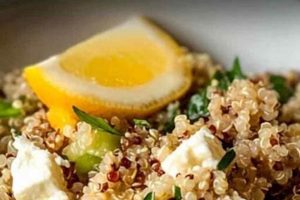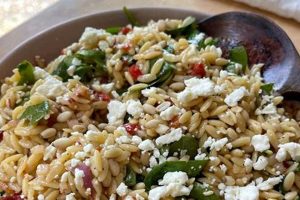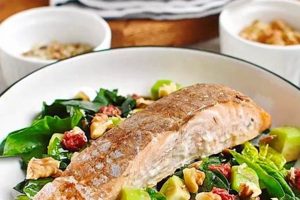A guide for preparing a dish of cooked, chilled red potatoes combined with other ingredients constitutes a foundational element for a popular picnic and barbecue side. Typically, these ingredients include a creamy dressing (often mayonnaise-based), vegetables (such as celery and onion), and seasonings (like mustard, dill, and paprika). Variations exist, incorporating different herbs, spices, and additions like hard-boiled eggs or bacon.
This culinary roadmap offers a structured approach to creating a consistent and flavorful outcome. Its value lies in providing precise measurements and step-by-step instructions, ensuring the dish is replicable and meets specific taste expectations. Historically, potato salad has evolved from simpler forms, reflecting changing culinary trends and ingredient availability. The use of red potatoes, known for their firm texture and waxy consistency, contributes to a salad that holds its shape well and avoids becoming mushy.
The following sections will explore various approaches to this classic dish, offering insights into ingredient selection, preparation techniques, and serving suggestions. From classic recipes to innovative interpretations, there is a version to suit every palate and occasion.
Tips for Red Potato Salad Success
Achieving optimal results with red potato salad involves attention to detail throughout the preparation process. These tips offer guidance for creating a flavorful and visually appealing dish.
Tip 1: Uniform Potato Size: Cutting potatoes into uniform pieces ensures even cooking. Aim for pieces roughly one inch in size. This prevents some pieces from being overcooked while others remain underdone.
Tip 2: Gentle Boiling: Overcooked potatoes become mushy. Cook potatoes until tender but still firm, easily pierced with a fork but not falling apart. Avoid vigorous boiling.
Tip 3: Prompt Cooling: Cooling the cooked potatoes quickly helps maintain their texture and prevents them from absorbing too much dressing. Drain the potatoes immediately after cooking and spread them out on a baking sheet to cool.
Tip 4: Dressing Consistency: The dressing should be creamy and flavorful but not overly thick. Adjust the consistency by adding small amounts of milk or buttermilk if needed.
Tip 5: Flavor Balancing: Achieve a balanced flavor profile by using a combination of tangy, savory, and subtly sweet ingredients. A touch of acidity from vinegar or lemon juice complements the richness of the mayonnaise.
Tip 6: Ingredient Incorporation: Gently fold the dressing and other ingredients into the cooled potatoes to avoid breaking them. This maintains the salad’s appealing appearance.
Tip 7: Chilling Time: Allowing the salad to chill for at least an hour before serving allows the flavors to meld and develop fully. This enhances the overall taste experience.
By following these guidelines, one can create a red potato salad that is both delicious and visually appealing. Careful attention to these details elevates this classic dish from simple to exceptional.
The following section provides concluding thoughts on the versatility and enduring appeal of red potato salad.
1. Ingredients
The selection and quality of ingredients directly impact the flavor, texture, and overall success of a red potato salad. Careful consideration of each component contributes to a well-balanced and satisfying final product. The following facets explore key ingredient categories and their contributions.
- Potatoes:
Red potatoes, with their waxy texture and thin skin, are ideal for potato salad as they hold their shape well during cooking and absorb flavors effectively. Alternatives, such as Yukon Gold or fingerling potatoes, can be substituted but may result in a slightly different texture.
- Dressing:
The dressing serves as the unifying element, binding the ingredients and providing a creamy, flavorful coating. Mayonnaise-based dressings are traditional, but variations incorporating sour cream, yogurt, or vinaigrette offer lighter alternatives. The choice of dressing influences the overall richness and tanginess of the salad.
- Vegetables:
Beyond potatoes, additional vegetables add textural and flavor complexity. Common additions include celery, onion, and bell peppers, providing crunch and contrasting flavors. Other vegetables, such as chopped pickles or green beans, can introduce unique flavor profiles.
- Seasonings:
Seasonings elevate the flavor profile beyond the base ingredients. Mustard, dill, paprika, and chives are frequently used, adding depth and complexity. Experimentation with different herbs, spices, and acidic elements like vinegar or lemon juice allows for personalized flavor combinations.
The interplay of these ingredient categories defines the character of the red potato salad. A thoughtful combination of high-quality ingredients, balanced flavors, and textural contrast creates a dish that is both satisfying and memorable. Harmonizing these elements through careful selection and proportioning is essential for achieving optimal results.
2. Preparation
Preparation constitutes a critical stage in executing a successful red potato salad recipe. Proper techniques ensure optimal texture, flavor development, and overall quality of the final dish. Careful attention to detail during this phase lays the groundwork for a satisfying culinary experience. The following facets explore key preparatory steps and their significance.
- Potato Handling:
Washing and scrubbing potatoes removes dirt and debris, contributing to a cleaner final product. Choosing whether to peel or leave the skins intact influences both the aesthetic and textural outcome. Peeling yields a smoother, more uniform salad, while leaving the skins on adds rustic appeal and retains nutrients.
- Cutting Technique:
Uniformly sized potato pieces ensure even cooking. Dicing potatoes into roughly one-inch cubes promotes consistent texture throughout the salad. Larger pieces may result in uneven cooking, with some portions overcooked while others remain underdone. Smaller pieces, conversely, risk becoming mushy during the cooking process.
- Pre-Cooking Steps:
Soaking cut potatoes in cold water before cooking removes excess starch, preventing the salad from becoming gummy. This step also helps maintain the potatoes’ shape and color during boiling. Adding a touch of vinegar or lemon juice to the soaking water further enhances color retention and adds a subtle tang.
- Ingredient Preparation:
Chopping other vegetables, such as celery and onions, to a similar size as the potatoes ensures visual appeal and balanced distribution of flavors throughout the salad. Preparing the dressing ingredients in advance streamlines the final mixing process and allows flavors to meld.
These preparatory steps collectively contribute to the overall success of the red potato salad. Attention to detail during this phase optimizes the cooking process, enhances flavor development, and creates a visually appealing final dish. Thorough preparation ultimately elevates the red potato salad from a simple side dish to a culinary highlight.
3. Cooking Method
The cooking method employed for the potatoes significantly influences the texture, flavor, and overall success of a red potato salad. Selecting the appropriate technique and executing it correctly ensures the potatoes reach the desired level of doneness without becoming mushy or disintegrating. This section explores various cooking methods and their implications for red potato salad preparation.
- Boiling:
Boiling is the most common method for cooking potatoes for salad. It involves submerging the potatoes in boiling water and cooking until tender but firm. Proper timing is crucial to prevent overcooking. Adding salt to the boiling water enhances flavor and helps maintain the potatoes’ shape. Draining the potatoes immediately after cooking prevents further softening.
- Steaming:
Steaming offers a gentler approach, preserving the potatoes’ nutrients and minimizing the risk of overcooking. Steamed potatoes retain their shape well and possess a delicate texture. This method requires specialized equipment, such as a steamer basket or insert, and slightly longer cooking times compared to boiling.
- Roasting:
Roasting introduces a distinct flavor profile and texture to the potatoes. Roasted potatoes develop a crispy exterior and a creamy interior, adding a contrasting element to the salad. This method requires tossing the potatoes with oil and seasonings before roasting in a preheated oven. Roasting necessitates longer cooking times than boiling or steaming.
- Microwaving:
Microwaving offers a rapid cooking method, ideal for smaller batches or time-constrained situations. Potatoes can be cooked in the microwave with a small amount of water until tender. This method requires careful monitoring to prevent overcooking. Microwaved potatoes generally lack the nuanced flavor development achieved through other cooking methods.
The chosen cooking method directly impacts the final texture and flavor profile of the red potato salad. While boiling remains the conventional approach, alternative methods like steaming and roasting offer unique textural and flavor dimensions. Selecting the most appropriate technique depends on individual preferences and desired outcomes, contributing to a diverse range of red potato salad variations.
4. Dressing
Dressing constitutes a pivotal component within red potato salad, significantly influencing the final flavor profile, texture, and overall cohesion. It acts as the unifying element, binding the individual ingredients and imparting a creamy, flavorful coating. The choice of dressing dictates the overall character of the salad, ranging from tangy and vibrant to rich and savory. A well-balanced dressing complements the inherent flavors of the potatoes and other vegetables without overpowering them, creating a harmonious blend of tastes and textures.
Classic red potato salad dressings typically feature a mayonnaise base. Mayonnaise provides a rich, creamy texture and a subtly tangy flavor that pairs well with the potatoes. Variations incorporate sour cream or yogurt for a lighter, tangier profile. The addition of mustard contributes a sharp, savory note, while vinegar or lemon juice provides acidity to balance the richness. Fresh herbs, such as dill, chives, or parsley, infuse the dressing with aromatic complexity. Hard-boiled eggs, finely chopped, add a creamy texture and subtle richness. The interplay of these ingredients creates a multi-dimensional flavor experience, elevating the red potato salad beyond a simple combination of components.
Beyond traditional mayonnaise-based dressings, vinaigrette-style dressings offer a lighter, more vibrant alternative. Vinaigrettes typically combine oil, vinegar, and seasonings, creating a tangy, refreshing counterpoint to the creamy potatoes. These dressings are particularly well-suited for warmer climates or lighter meals. The choice of oil and vinegar significantly influences the flavor profile. Olive oil imparts a robust, fruity flavor, while lighter oils like canola or grapeseed oil offer a more neutral base. The type of vinegarsuch as red wine vinegar, apple cider vinegar, or balsamic vinegarintroduces varying levels of acidity and sweetness. The interplay of these elements within the dressing creates a complex interplay of flavors that enhances the overall appeal of the red potato salad.
5. Seasoning
Seasoning plays a crucial role in defining the flavor profile of red potato salad, elevating it from simple to complex. It provides depth, balance, and vibrancy, transforming the inherent flavors of the core ingredients. Without proper seasoning, red potato salad can taste bland and uninspired. The careful selection and application of seasonings enhance the overall sensory experience, creating a harmonious blend of tastes that complement the creamy texture of the potatoes and other components.
Several seasonings contribute significantly to a well-balanced red potato salad. Mustard, in its various forms, adds a sharp, tangy note that cuts through the richness of the mayonnaise. Dill, with its bright, herbaceous flavor, complements the potatoes and other vegetables. Paprika provides a subtle smokiness and a touch of color. Celery seed offers an earthy, slightly bitter counterpoint. Fresh herbs like chives and parsley introduce a fresh, vibrant element. Salt and black pepper are essential for enhancing overall flavor and balancing the other seasonings. The specific combination and proportions of these seasonings can be adjusted to create unique flavor profiles tailored to individual preferences.
The impact of seasoning extends beyond mere flavor enhancement. It also contributes to the overall balance and complexity of the dish. A well-seasoned red potato salad exhibits a harmonious interplay of sweet, sour, salty, and savory notes. The careful application of seasonings allows for nuanced flavor layering, creating a dish that is both satisfying and memorable. Understanding the role and impact of each seasoning empowers culinary exploration and allows for the creation of personalized variations on the classic red potato salad recipe. This knowledge ensures a consistently flavorful and enjoyable outcome, transforming a simple side dish into a culinary highlight.
6. Presentation
Presentation elevates red potato salad from a simple side dish to a visually appealing culinary creation. While flavor remains paramount, presentation enhances the dining experience, stimulating appetite and conveying care in preparation. Consideration of visual elements transforms the dish, adding a layer of sophistication and enjoyment. The manner in which the salad is arranged and served significantly impacts its perceived value and overall appeal.
Several factors contribute to effective presentation. Choosing the right serving vessel plays a key role. A simple glass bowl showcases the vibrant colors and textures of the salad, while a rustic wooden bowl adds a touch of homestyle charm. Garnishing with fresh herbs, such as sprigs of dill or chopped chives, adds a pop of color and reinforces the flavors within the salad. A sprinkle of paprika or a dusting of finely chopped hard-boiled egg adds visual interest and textural contrast. Arranging the salad on a bed of lettuce leaves adds a touch of elegance and freshness. For individual servings, using small ramekins or scooped onto endive leaves creates a visually appealing and manageable portion. These seemingly small details demonstrate attention to detail and elevate the perceived quality of the dish. For example, a catered event might present individual portions in elegant martini glasses, while a family picnic might opt for a rustic communal bowl garnished with fresh herbs.
Ultimately, presentation enhances the enjoyment of red potato salad by engaging multiple senses. A visually appealing dish stimulates appetite and creates anticipation for the flavors to come. Thoughtful presentation signifies care and attention to detail, transforming a simple side dish into a more memorable culinary experience. While a delicious recipe forms the foundation, effective presentation completes the experience, making red potato salad a feast for both the eyes and the palate. This understanding allows one to appreciate the crucial role of presentation in elevating even simple dishes to a higher level of culinary artistry.
Frequently Asked Questions
This section addresses common inquiries regarding red potato salad preparation, offering concise and informative responses to facilitate a successful culinary outcome. Clarifying these points aims to preempt potential challenges and ensure consistent results.
Question 1: How can one prevent red potatoes from becoming mushy in potato salad?
Preventing mushiness involves careful attention to cooking time and temperature. Cook potatoes until tender but still firm, avoiding overboiling. Rapid cooling after cooking also helps maintain texture.
Question 2: What are suitable alternatives to mayonnaise in red potato salad dressing?
Alternatives to mayonnaise include plain yogurt, sour cream, or a vinaigrette base for a lighter dressing. These options offer varying textures and flavor profiles.
Question 3: Can red potato skins be left on for potato salad?
Leaving the skins on adds a rustic aesthetic and retains nutrients. Ensure thorough washing before cooking. If a smoother texture is desired, peeling is recommended.
Question 4: How long should red potato salad be chilled before serving?
Chilling for at least one hour allows flavors to meld. Longer chilling enhances flavor development but avoid excessive chilling, which can negatively impact texture.
Question 5: What can be added to red potato salad beyond the traditional ingredients?
Additions can include hard-boiled eggs, bacon, chopped pickles, or different herbs and spices. These additions introduce varied textures and flavor dimensions.
Question 6: How can one prevent discoloration in red potato salad?
Adding a splash of vinegar or lemon juice to the cooking water helps maintain color. Storing the salad in an airtight container minimizes oxidation and discoloration.
Addressing these common inquiries provides a foundation for successful red potato salad preparation. Attention to detail and understanding the underlying principles ensures consistent quality and flavor.
The following section will offer a collection of varied red potato salad recipes.
Recipe for Red Potato Salad
Exploration of the elements comprising a successful formulation for red potato salad reveals the importance of ingredient selection, preparation techniques, cooking methods, dressing composition, seasoning choices, and presentation. Each component contributes significantly to the final product’s overall quality, flavor profile, and aesthetic appeal. From the selection of waxy red potatoes to the nuanced balance of seasonings, careful consideration of each step ensures a consistently satisfying outcome. Understanding these interconnected elements empowers culinary practitioners to create a dish that transcends basic sustenance and becomes a true culinary expression.
Mastery of the foundational principles underlying red potato salad preparation allows for adaptation and innovation within this classic dish. Exploration of diverse ingredient combinations, varied cooking methods, and creative presentation styles expands culinary horizons. The seemingly simple act of combining cooked potatoes with complementary ingredients offers a canvas for culinary creativity, demonstrating the potential for depth and complexity within even the most familiar dishes. Continued exploration and refinement of technique promise a future rich with innovative interpretations of this enduring culinary staple.






